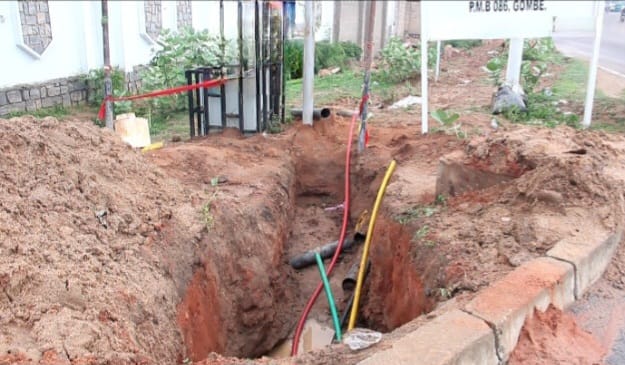Rising Spate of Cable Theft In Nigeria: Whose Fault?
By Shuaib Shuaib Agaka
While cable theft might seem like a localized issue affecting the telecom industry, its repercussions extend far beyond severed wires and interrupted services. This covert practice has evolved into a significant threat, imposing substantial costs on both telecom companies and society at large. The pilfering of telecom cables, often for their valuable copper components, has become an all-too-common occurrence, leading to service disruptions, financial losses, and even jeopardizing public safety during critical moments.
Telecom companies, entrusted with providing seamless communication services, find themselves battling an elusive enemy. Despite investing heavily in both technologies and security measures, they continue to face relentless attacks on their infrastructure. The vulnerability of telecom cables to theft highlights systemic weaknesses in safeguarding critical assets.
The economic costs associated with cable theft are staggering. Telecom companies bear the expenses of repairing and replacing stolen cables, not to mention the revenue losses incurred during service downtime. These costs ultimately trickle down to consumers in the form of higher service charges, creating an economic burden that reverberates throughout society.
During 2022, mobile network operators spent more than N13 billion repairing damages to fiber cuts and other telecommunication infrastructure. By 2023, this expenditure had surged to N27 billion.
Additionally, telecommunications sector operators experienced revenue declines totaling N12 billion in both 2022 and 2023, primarily attributed to expenses related to customer compensation, site relocations, and investments in fiber resilience.
Moreover, the impact of cable theft extends well beyond the immediate financial losses incurred by telecom companies. Disrupted communication services not only inconvenience customers but also disrupt vital operations for businesses, emergency services, and government agencies. Imagine a scenario where a critical call for help or a time-sensitive business transaction is thwarted due to a stolen cable—such disruptions can have far-reaching consequences.
Furthermore, cable theft has a ripple effect on national economies. In an increasingly interconnected world reliant on seamless communication, any disruption in telecom services can impede productivity, disrupt supply chains, and dampen economic growth.
Countries with high incidences of cable theft may find themselves at a competitive disadvantage, deterring foreign investments and innovation in telecommunications infrastructure.
The blame game surrounding cable theft inevitably leads us to scrutinize the preparedness and responsibility of telecom companies, whose infrastructure forms the primary target for thieves. Despite being aware of the persistent threat posed by cable theft, telecom companies have been criticized for their perceived lack of adequate measures to deter and prevent such incidents.
One of the fundamental issues highlighted is the vulnerability of telecom infrastructure due to inadequate physical security measures. Many telecom cables are laid underground or strung along utility poles, making them accessible to determined thieves. The absence of robust barriers, alarms, or surveillance systems in vulnerable areas increases the risk of unauthorized access and theft.
Moreover, the scale of telecom networks spanning vast geographical areas poses logistical challenges in monitoring and securing every inch of cable infrastructure effectively. Maintaining round-the-clock surveillance and rapid response capabilities across sprawling networks requires substantial investments in manpower and technology, which some telecom companies may deem cost-prohibitive.
Furthermore, the reliance on traditional security measures such as fences, locks, and periodic patrols may no longer suffice in deterring sophisticated theft syndicates equipped with advanced tools and techniques.
Critics argue that while telecom companies prioritize customer acquisition and service expansion to remain competitive, investments in robust security infrastructure often take a back seat. This approach focused more on addressing incidents after they occur rather than proactively preventing them, underscores the need for a paradigm shift in risk management strategies within the telecom industry.
Another player in the blame game is law enforcement. Examining the role of law enforcement in addressing cable theft reveals a landscape filled with challenges and complexities.
Read Also:
While law enforcement agencies are tasked with maintaining public safety and upholding the rule of law, their effectiveness in combating cable theft has often been called into question.
One of the primary challenges faced by law enforcement agencies is the nature of cable theft operations. Unlike conventional crimes that may occur in plain sight or leave tangible evidence, cable theft often takes place in remote or unmonitored locations, most times, making detection and apprehension of perpetrators difficult.
The transitory nature of cable theft exploiting legal loopholes further complicates law enforcement efforts. Coordinating investigations, sharing intelligence, and conducting seamless cross-border operations require robust collaboration and cooperation among law enforcement agencies at local and regional levels.
Moreover, scrutinizing the loss incurred in cable theft, the prioritization of law enforcement resources towards high-profile crimes or immediate public safety concerns should not relegate cable theft investigations to lower priority status.
Also, the complex and time-consuming nature of gathering evidence, conducting surveillance, and building cases against organized theft rings may not always align with the swift responses expected in more visible criminal activities.
Another critical issue is the lack of specialized training and expertise within law enforcement agencies specifically tailored to combatting cable theft. Understanding the intricacies of telecom infrastructure, analyzing theft patterns, and deploying technological solutions require specialized knowledge and skills that may not be readily available across all law enforcement personnel.
Also, the role of government emerges as a critical factor in addressing this pervasive problem when examining the blame game surrounding cable theft. Governments, through regulatory frameworks, law enforcement support, and infrastructure protection initiatives, wield significant influence in shaping the landscape for combating cable theft and safeguarding critical telecom infrastructure.
One of the primary criticisms directed toward governments is the perceived lack of robust regulatory frameworks specifically targeting cable theft. While theft of telecom cables constitutes a significant economic crime with wide-ranging impacts, the absence of stringent laws and penalties tailored to deter such offenses undermines efforts to curb theft activities effectively.
Furthermore, harmonizing regulations, establishing clear guidelines for infrastructure protection, and imposing severe penalties on offenders are imperative steps that governments must take to signal their seriousness in combating cable theft.
Government agencies responsible for telecommunications oversight and infrastructure protection must collaborate closely with law enforcement counterparts to develop targeted strategies, share intelligence, and deploy resources effectively in combating cable theft. This collaborative approach can bridge gaps between regulatory compliance and law enforcement action, ensuring a more comprehensive response to the cable theft menace.
Investments in technological solutions and innovation are also areas where governments can significantly contribute to mitigating cable theft risks. Supporting research and development efforts for tamper-proof cable designs, advanced surveillance systems, and data analytics tools can provide valuable tools for both industry stakeholders and law enforcement agencies in combating theft incidents.
Beyond regulatory and enforcement aspects, governments must also prioritize public awareness campaigns and community engagement initiatives to mobilize citizen participation in reporting suspicious activities and safeguarding critical infrastructure. Empowering communities with knowledge about the impacts of cable theft and the importance of reporting incidents can create a collective vigilance that complements formal security measures. While creating awareness, a significant emphasis must be placed on the penalty for cable theft.
In reflecting on the multifaceted challenges and responsibilities surrounding cable theft, it becomes evident that a collective and proactive approach is imperative to mitigate the issue. The blame game among telecom companies, law enforcement agencies, and governments must give way to collaborative strategies that address the root causes and consequences of cable theft comprehensively.
To achieve lasting peace regarding the issue, it is crucial to address the aforementioned problems comprehensively while also giving due consideration to the recommendations provided because the high cost of cable theft underscores the urgent need for coordinated action and shared responsibility. The time for decisive and collaborative action against cable theft is now, and only through concerted efforts can we effectively combat this persistent threat.




















